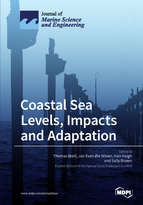Coastal Sea Levels, Impacts and Adaptation
A special issue of Journal of Marine Science and Engineering (ISSN 2077-1312).
Deadline for manuscript submissions: closed (31 May 2017) | Viewed by 140741
Special Issue Editors
2. Engineering and the Environment, University of Southampton, Southampton, UK
Interests: changes in sea level; storm surges; ocean waves; precipitation; river discharges; (coastal-)engineering design concepts; extreme value analysis; climate adaptation and resilience; integrated coastal vulnerability and risk assessment; stochastic and numerical modelling of tides, storm surges, waves and river flows; multi hazards; coastal processes and hydrodynamics
Interests: physical oceanography; sea level change; sea level variability; sea level projections and predictions; steric and dynamic contribution to sea level variability and change; climatic processes in the Atlantic, Nordic, and Arctic Seas; water mass transformation and deep water formation; thermohaline circulation; large scale circulation; large scale forcing
Interests: sea level, storm surges, extreme events, coastal flooding, extreme value analysis; local, regional and global scales; flood and erosion risk-based management and planning; process based numerical modelling
Interests: impacts of sea-level rise; adaptation; risk; geomorphology; flooding; erosion; shoreline management; ports; deltas; small islands
Special Issue Information
Dear Colleagues,
Extreme sea levels can lead to hazardous events—such as coastal flooding, erosion, or salt water intrusion—with wide ranging environmental, societal and economic consequences. In combination with climate-driven sea-level rise, and, potentially, additional changes in storminess, dynamic wave contributions, or tidal dynamics, the adverse consequences of extreme oceanographic events are in many regions projected to escalate. Integrated coastal zone impact assessments can guide decisions on adaptive response to these changes in the physical environment and socio-economic development. To achieve this, we require:
- An improved understanding from observations and modelling studies of the processes involved in driving regional and local mean sea level changes at different time scales.
- Robust projections and the inherent uncertainties (including upper-tail risks) of regional and local mean level changes over the next few decades and longer time scales.
- Accurate estimates of present-day extreme sea levels (and associated uncertainties) and potential future changes in storminess adding to trends and variability in mean sea level.
- Models capable of simulating impacts from sea-level change and extremes, such as flooding, erosion, or ecosystem degradation, taking into account socio-economic change and adaptation.
- Co-designed projects and cross-disciplinary collaboration between engineers, natural, social, and economic scientists, stakeholders, and policy makers.
For this Special Issue we invite contributions that address one or more of the above topics from a natural science, engineering, or socio-economic perspective.
Dr. Thomas Wahl
Dr. Jan Even Øie Nilsen
Dr. Ivan Haigh
Dr Sally Brown
Guest Editors
Manuscript Submission Information
Manuscripts should be submitted online at www.mdpi.com by registering and logging in to this website. Once you are registered, click here to go to the submission form. Manuscripts can be submitted until the deadline. All submissions that pass pre-check are peer-reviewed. Accepted papers will be published continuously in the journal (as soon as accepted) and will be listed together on the special issue website. Research articles, review articles as well as short communications are invited. For planned papers, a title and short abstract (about 100 words) can be sent to the Editorial Office for announcement on this website.
Submitted manuscripts should not have been published previously, nor be under consideration for publication elsewhere (except conference proceedings papers). All manuscripts are thoroughly refereed through a single-blind peer-review process. A guide for authors and other relevant information for submission of manuscripts is available on the Instructions for Authors page. Journal of Marine Science and Engineering is an international peer-reviewed open access monthly journal published by MDPI.
Please visit the Instructions for Authors page before submitting a manuscript. The Article Processing Charge (APC) for publication in this open access journal is 2600 CHF (Swiss Francs). Submitted papers should be well formatted and use good English. Authors may use MDPI's English editing service prior to publication or during author revisions.
Keywords
- mean sea level rise and variability
- storm surges, waves, tides
- extreme value analysis
- coastal vulnerability and impacts
- risk management
- governance and socio-economic change






